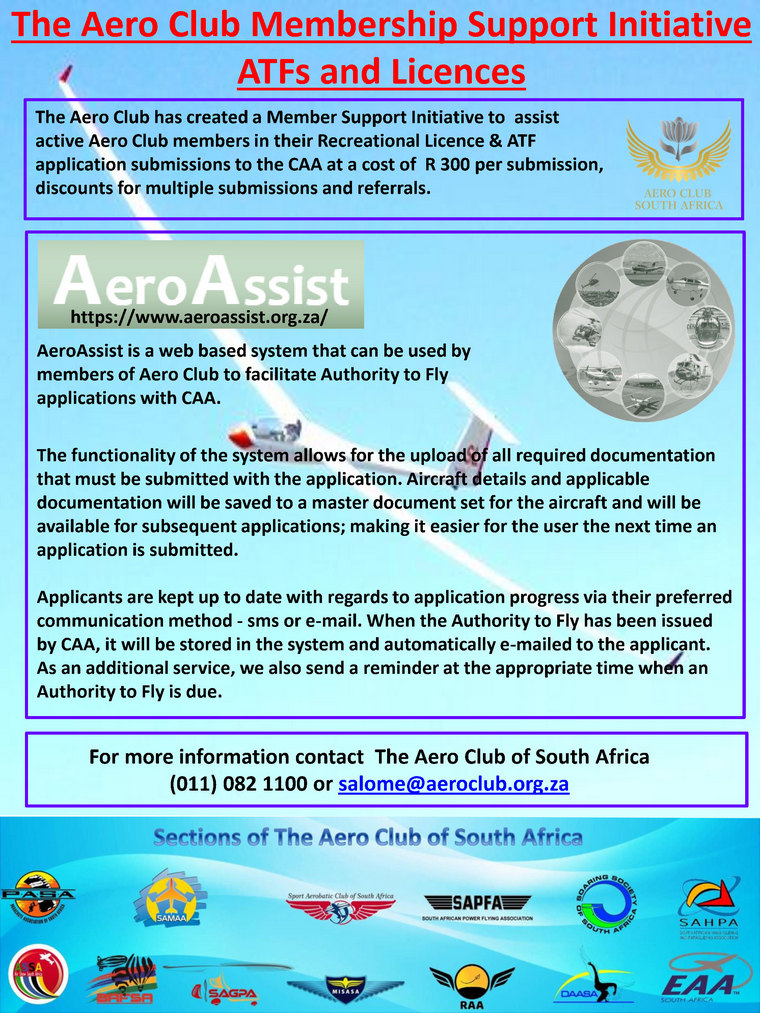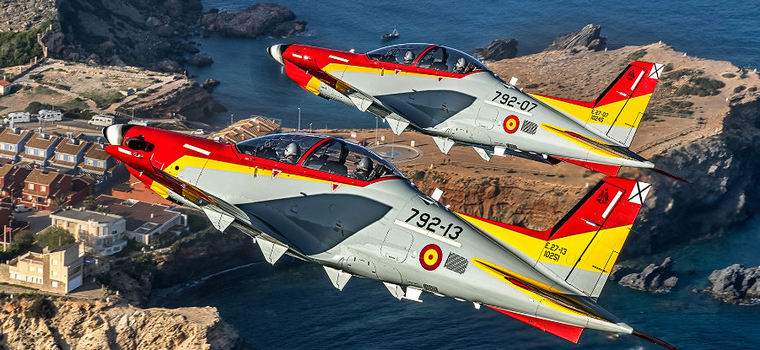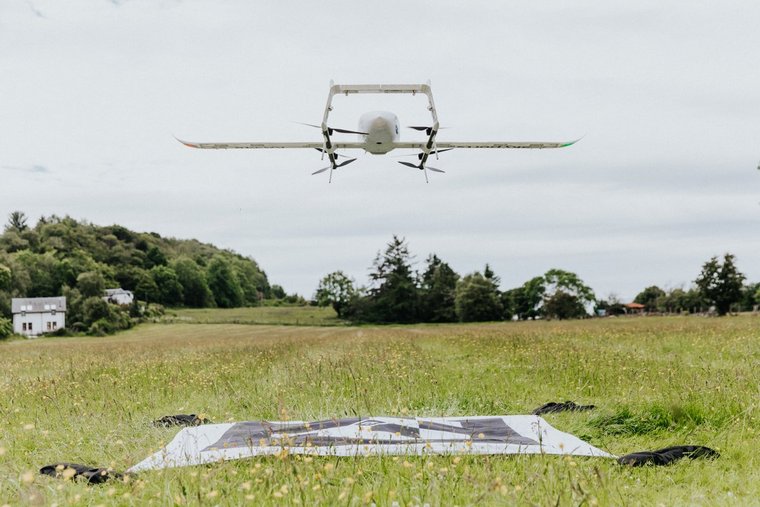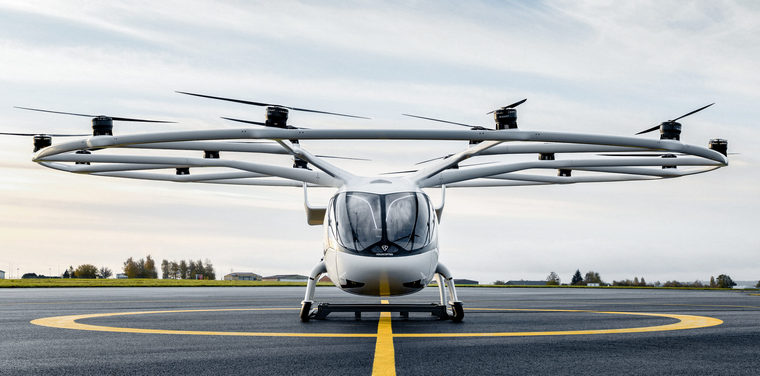








Midweek Update 20 April 2023Google Banner Ad THIS WEEK IN MIDWEEK UPDATE SUN 'n FUN Aerospace Expo 2023 was a success! Rain remotely commands Black Hawk helicopter for firefighting missions. Autopilot system for Bell 407GXI certified in the United Kingdom. Robinson Helicopters, more R66 Police Helicopters on patrol. Pentagon and Lockheed Martin finalise Lot 15-17 agreement. Northrop Grumman F-16 electronic warfare suite counters modern radio frequency threats during air force testing. The Spanish Air Force buys another 16 PC-21s & associated simulators. Skyports Drone Services to launch drone delivery flights for Royal Mail. Volocopter Completes Production Setup for Electric Air Taxis. Worldwide incidents and accidents - USA Springfield, Illinois Piper PA60. This week in history - 7 April 1908 - The members of the Aerial Experiment Association enter a competition sponsored by the Scientific American, which has offered $25,000 for a flight of over 0.62 miles. Bonus Video - Kodiak Bishop's Cove to George Airport    19 to 22 AERO Friedrichshafen Germany. Contact Tobias Brezel E-mail: tobias.bretzel@fairnamic 22 Elders Flight Brakpan Airfield. Contact Felix Gosher E-mail: felixgosher@gnmail.com Cell: 086 191 4603   4 to 7 Kalahari Bundu Bash Adventure Koppieskraal Pan. Contact Cell: 078 459 2636 or 054 331 3534 E-mail: kbb@rafsa.co.za 4 to 8 NAC fly-away to Namibia. Contact Agnes Phillips E-mail: agnes.phillips@nac 5 to 7 BONA BONA fly-in at the Bona Bona airfield and country lodge. Contact Christian E-mail: christian@vsg.co.za Cell 083 251 4573 5 & 6 SAAF Museum annual airs how AFB Swartkops. Contact Maj. Ntshangase. Zero 8 three four one 0166 five 6 EAA Chapter 322 monthly gathering 07h30 EAA Auditorium Rand Airport. Contact Neil Bowden E-mail: airadventuresa@gmail.com 6 to 7 SAPFA Speed Rally at Bona Bona airfield. Contact David le Roux E-mail: david@pilotinsure.co.za Cell 073 338 5200 13 Lowveld Airshow at Nelspruit airfield. For more info contact Johan@kishugu.com Cell: 082 456 7 to 14 Sling Africa Tour: Departing from the Kalahari Bundu Bash led by Mike and Sue. Contact Shanelle Visagie E-mail: Shannelle@slingairctaft.com 16 to 19 Grain SA's NAMPO Harvest Day. Contact Wim Venter E-mail: wim@grainsa.co.za Tel: 086 004 7246 17 to 20 SAC National Aerobatics Championships Tempe airfield. Contact Annie Boon E-mail: info@anniesaviationcorner.com 18 & 19 Orion training, tech, drones and unmanned aviation conference. Contact Thabo Ndimande E-mail: thabo@orion-training.co.za Cell: 072 663 2724 20 New Tempe airshow Bloemfontein. Contact Conrad Botha E-mail: rowco24cc@mailbox.co.za Cell: 082 770 5505 20 May SAA Museum Hobby and Collectables Fair Rand Airport. Contact E-mail: events@saamuseum.co.za Cell: 076 879 5044 25 to 28 SAPFA Presidents' Trophy Air Race Middleburg airfield Website: www.sapfa  - Copy.jpg)  1 & 2 Drones and Unmanned Aviation Conference Birchwood Hotel. Contact Gerald E-mail: admin@bussynetadt.co.za Cell: 067 611 0365 or Byron E-mail: byron@bussynetadt.co.za Cell: 067 611 0365 1 to 4 RC Extravaganza at Henley Model airfield. Contact Emil Henrico E-mail: info@rcasa.org.za Cell: 082 962 2334 3 EAA Chapter 322 breakfast gathering 07h30 EAA Auditorium Rand Airport. Contact Neil Bowden E-mail: airadventuresa@gmail.com 3 Parys Airshow. Contact Brendan Horan E-mail: brendan@creativespacemedia.co.za 10 EAA Young Eagles Day (Venue TBA) & EAA International Young Eagles Day. Contact Neil Bowden E-mail: airadventuresa@gmail.com 10 Newcastle Airshow. Contact Johan Pieters E-mail: johan@champ.co.za 9 to 11 EAA Convention. Middelburg Airfield. Rsvp@eaa.org.za 11 Brakpan Aero Club Cobra Club and fly-in. Contact Clarissa E-mail: Clarissa@airborneaviation.co.za Cell: 074 113 2911 15 Virginia Airport Air Show, Durban. Brendan Horan E-mail: brendan@creativespacemedia.co.za 16 SAC Fundraiser event venue TBA. Contact Annie Boon E-mail: info@anniesaviationcorner.com 17 Maputo International Airshow on the waterfront. Contact Gavin Neil E-mail: gavin@haps.co.mz Cell: +258 84 391 7408 30 June to 2 July EAA Taildraggers at Warmbaths airfield (Bela Bela). Contact Richard Nicholson E-mail: ichard.nicholson1963@gmail   SUN 'N FUN AEROSPACE EXPO 2023 WAS A SUCCESS!  RAIN REMOTELY COMMANDS BLACK HAWK HELICOPTER FOR FIREFIGHTING MISSIONS Rain Industries, a leader in automated rapid initial wildfire suppression, has added the Sikorsky UH-60 Black Hawk to its list of supported aircraft, demonstrating the ability to remotely command the aircraft via satellite link from a central command centre. This milestone event showcases early steps towards a network of automated aircraft capable of rapidly responding to ignitions to prevent catastrophic wildfires. Rain integrates with these camera feeds and other early detection sensors to dispatch nearby autonomous helicopters within seconds, Rain's Chief Engineer, Ephraim Nowak, states, "this is a critical first proof-of-concept to illustrate how our software will allow uncrewed aircraft to support firefighting missions." The Black Hawk, and its firefighting variant the Firehawk®, are familiar aircraft in the fire service, trusted by agencies such as CAL FIRE, the US Forest Service, and many others around the world. In addition to this recent integration with the Black Hawk, Rain has previously demonstrated an un- crewed Mosquito helicopter containing a test ignition. In California alone there are already over one thousand fire watch cameras continuously monitoring over 90% of the so that fires can be contained within minutes.  AUTOPILOT SYSTEM FOR BELL 407GXI CERTIFIED IN THE UNITED KINGDOM  Bell Textron Inc., a Textron Inc. (NYSE: TXT) company, announced that the Bell 407GXi 3-axis autopilot has received certification from the United Kingdom's Civil Aviation Authority (CAA). It is available in the two and three-axis configurations: the two-axis version includes pitch control (altitude hold, IAS hold) and roll control (HDG hold, NAV, vertical navigation mode), and the three-axis option adds yaw control. In addition, the system is equipped with: Stability augmentation system to automatically recover the aircraft to near-level flight attitude at all speeds in the event of adverse roll or pitch. Stability engagement throughout all phases of flight. Envelope protection to prevent over speeding and under speeding. Owners can specify the autopilot system on new Bell 407GXis or have the system retrofitted. With the autopilot, advanced Garmin avionics, and a dual channel FADEC-controlled engine, the Bell 407GXi continues to set high standards for single-engine aircraft with its advanced technical features. There are currently 1,500 Bell 407s operating across all six continents totalling more than six million flight hours.  ROBINSON HELICOPTERS, MORE R66 POLICE HELICOPTERS ON PATROL.  The Polk County Sheriff's Office (PCSO) Aviation Unit took delivery of its third R66 Police Helicopter, replacing its aging MD 500 fleet. The Aviation Unit's fleet now consists of three R66 Police Helicopters and one Cessna 182T. In October and December 2022, RHC delivered two new R66 Police Helicopters to Helisul Aviation, the largest operator of single-engine helicopters in Latin America. The helicopters will be used to support the Brazilian Paraná State Police. HeliSul has since placed two more orders for R66 Police Helicopters, which are slotted for delivery this summer.  PENTAGON AND LOCKHEED MARTIN FINALIZE LOT 15-17 AGREEMENT  The F-35 Joint Program Office and Lockheed Martin have finalized the contract for the production and delivery for up to 398 F-35s for $30 billion, including U.S., international partners and Foreign Military Sales (FMS) aircraft in Lots 15 and 16, with the option for Lot 17.  Lot 15-17 aircraft will be the first to include Technical Refresh-3 (TR-3), the modernized hardware needed to power Block 4 capabilities. TR-3 includes a new integrated core processor with greater computing power, a panoramic cockpit displays and an enhanced memory unit. These aircraft will add to the growing global fleet, currently at 894 aircraft after 141 deliveries this year. The F-35 team was on track to meet the commitment of 148 aircraft as planned; however, due to a temporary pause in flight operations, which is still in effect, necessary acceptance flight tests could not be performed. The finalised contract caps off a year of the F-35 delivering combat-proven airpower around the world and continued international growth. This year, Finland, Germany and Switzerland signed Letters of Offer and Acceptance (LOAs) as an important step in their procurement of F-35 aircraft. "Continuing to add new countries to our global F-35 fleet further validates the capability and affordability of this aircraft in providing 21st Century Security to nations and allies," said Bridget Lauderdale, Lockheed Martin vice president and general manager, F-35 Program. "There is simply no other aircraft that can do all that the F-35 does to defeat and deter even the most advanced threats." F-35 program participants currently include 17 countries. To date, more than 1,870 pilots and 13,500 maintainers have been trained, and the F-35 fleet has surpassed more than 602,000 cumulative flight hours.   Northrop Grumman Corporation's (NYSE: NOC) AN/ALQ-257 Integrated Viper Electronic Warfare Suite (IVEWS) has completed U.S. Air Force Laboratory Intelligence Validated Emulator (LIVE) testing. The system exceeded multiple benchmarks and demonstrated the ability to counter modern radio frequency (RF) threats. This was the first time the ultra-wideband architecture in IVEWS underwent LIVE testing. "As advanced radio frequency threats continue to proliferate, the protection afforded by IVEWS is essential," said James Conroy, vice president, navigation, targeting and survivability, Northrop Grumman. "This successful evaluation under very challenging conditions is an important step on the path to fielding the suite." Fully digital and founded on secure, modular, open systems design principles, the receiver/exciter architecture in IVEWS provides significant advantages over heritage systems. This technology allows for extended frequency coverage, full spatial coverage, and more rapid responses. Featuring highly efficient broadband power amplifiers and adaptive countermeasure modulations, it is designed to detect, identify, locate, and defeat next generation sensors and weapons. IVEWS is a program of record electronic warfare suite for the U.S. Air Force F-16 fleet. The system is exportable for current and previous generations of F-16 aircraft.  THE SPANISH AIR FORCE BUYS ANOTHER 16 PC-21S & ASSOCIATED SIMULATORS  The Spanish Air Force, Ejército del Aire, decided to purchase 24 PC-21s in early 2020. The final PC-21 of this order was delivered to Spain in mid-2022. The Spanish Air Force has now decided to buy another 16 PC-21s. The contract signed with the Dirección General de Armamento y Material (DGAM) makes Spain the largest PC-21 operator in Europe. Lieutenant Colonel Ildefonso Martínez-Pardo González, Academia General del Aire (AGA) Air Operations Group Commander, commented as follows: "Now in use with the Spanish Air and Space Force for over 18 months, the PC-21 integrated training system far exceeds our expectations. Its reliable and efficient powerplant, aerodynamics, safety systems and avionics make the PC-21 a highly versatile trainer, capable of performing any phase of flight training from the most elementary to the most advanced. Our relationship with Pilatus has been outstanding throughout, and a key factor for successful implementation. The excellent collaboration, professionalism and teamwork of everyone involved over the past three years have enabled us to roll out this PC-21 training course in record time without interruption to training." 14 PC-21s will be delivered to the Academia General del Aire (AGA) in San Javier. An additional two PC-21s will also be delivered to the Centro Logístico de Armamento y Experimentación (CLAEX). These two PC-21s will be used for experimental, flight test training and research and development activities. The aircraft will be based in Torrejón near Madrid. The package also includes a PC-21 simulator, two cockpit procedure trainers, additional mission planning and debriefing systems as well as pilot training software.   Skyports Drone Services, the global leader in drone logistics, surveys and monitoring, has today announced the launch of the Orkney I-Port operation, a fully electric drone logistics project established in partnership with Royal Mail, Orkney Islands Council Harbour Authority and Loganair. The project is set to revolutionise connectivity, access and safety throughout the rural island region. Benefitting from Skyports Drone Services' extensive experience in the operation of highly automated cargo drones, the project will deliver two new capabilities: daily inter-port delivery of Royal Mail items and the demonstration of shore-to-ship deliveries. The I-Port project is significant as it represents the first UK drone delivery project which can be conducted on a permanent basis under existing regulatory frameworks, a milestone made possible due to the unique landscape of Orkney. Orkney's island geography and harsh weather impact the ability to provide an uninterrupted delivery service. Postal deliveries arrive from mainland Scotland to Kirkwall Airport via the Loganair RMA Orkney Flyer, where they are delivered to residents on Orkney's main island, Mainland, or transported to one of the 19 other inhabited islands via ferry or small passenger plane. Pauses in the ferry schedule are common during poor weather due the challenges of docking safely.  The project's shore-to-ship flight operations will demonstrate the benefit of a seamless link between Orkney Islands Council Harbour Authority and vessels in its port. Skyports Drone Services will provide logistics for several use-cases, including delivery of documentation and provisions and the transportation of bunker samples. Alongside the demonstration, Skyports Drone Services will conduct a feasibility study in partnership with Loganair to explore the future of heavy payload operations in Orkney.  VOLOCOPTER COMPLETES PRODUCTION SETUP FOR ELECTRIC AIR TAXIS  Volocopter, the pioneer of urban air mobility (UAM), announced yesterday the opening of its production facilities in Bruchsal. The company marked this milestone with the opening of a new hangar that will host the company's final assembly line with an airfield to conduct development flight tests as well as quality checks. All company-owned production sites, which will manufacture the first EASA-certified electric air taxis, will ramp up into full operation in April. From this facility, electric air taxis made in Germany will be deployed across the world, offering commercial services starting next year. The ribbon-cutting ceremony was held on 4 April 2023 at the hangar. The event also featured a crewed flight of the Volocopter 2X. Key guests included Dr. Volker Wissing, Federal Minister of Digital Affairs and Transport; Mr. Winfried Kretschmann, Minister of the State of Baden-Württemberg; Dr. Anna Christmann, Federal Government Coordinator for German Aerospace Policy; and upward of 70 business and political representatives.    USA SPRINGFIELD, ILLINOIS PIPER PA60 The pilot was conducting an instrument landing system (ILS) approach in instrument meteorological conditions at the conclusion of a cross-country flight. The airplane had been cleared to land, but the tower controller cancelled the landing clearance because the airplane appeared not to be established on the localizer as it approached the locator outer marker. The approach controller asked the pilot if he was having an issue with the airplane's navigation indicator, and the pilot replied, "yup." Rather than accept the controller's suggestion to use approach surveillance radar (ASR) approach instead of the ILS approach, the pilot chose to fly the ILS approach again. The pilot was vectored again for the ILS approach, and the controller issued an approach clearance after he confirmed that the pilot was receiving localizer indications on the airplane's navigation equipment. The airplane joined the localizer and proceeded toward the runway while descending. The pilot was instructed to contact the tower controller; shortly afterward, the airplane entered a left descending turn away from the localizer center line. At that time, the airplane was about 3 nautical miles from the locator outer marker. The pilot then told the tower controller, "we've got a prob." The tower controller told the pilot to climb and maintain 3,000 ft msl and to turn left to a heading of 180°. The pilot did not respond. During the final 5 seconds of recorded track data, the airplane's descent rate increased rapidly from 1,500 to about 5,450 ft per minute. The airplane impacted terrain about 1 nm left of the localizer center line in a left-wing-down and slightly nose down attitude at a groundspeed of about 90 knots. A postimpact fire ensued. Although the pilot was instrument rated, his recent instrument flight experience could not be determined with the available evidence for this investigation. Most of the fuselage, cockpit, and instrument panel was destroyed during the postimpact fire, but examination of the remaining wreckage revealed no anomalies. Acoustic analysis of audio sampled from doorbell security videos was consistent with the airplane's propellers rotating at a speed of 2,500 rpm before a sudden reduction in propeller speed to about 1,200 rpm about 2 seconds before impact. The airplane's flightpath was consistent with the airplane's avionics receiving a valid localizer signal during both instrument approaches. However, about 5 months before the accident, the pilot told the airplane's current maintainer that the horizontal situation indicator (HSI) displayed erroneous heading indications. The maintainer reported that a replacement HSI was purchased and shipped directly to the pilot to be installed in the airplane; however, the available evidence for the investigation did not show whether the malfunctioning HSI was replaced before the flight. The HSI installed in the airplane at the time of the accident sustained significant thermal and fire damage, which prevented testing. During both ILS approaches, the pilot was cleared to maintain 3,000 ft mean sea level (msl) until the airplane was established on the localizer. During the second ILS approach, the airplane descended immediately, even though the airplane was below the lower limit of the glideslope. Although a descent to the glideslope intercept altitude (2,100 ft msl) would have been acceptable after joining the localizer, such a descent was not consistent with how the pilot flew the previous ILS approach, during which he maintained the assigned altitude of 3,000 ft msl until the airplane intercepted the glideslope. If the HSI provided erroneous heading information during the flight, it could have increased the pilot's workload during the instrument approach and contributed to a breakdown in his instrument scan and his ability to recognize the airplane's deviation left of course and descent below the glideslope; however, it is unknown if the pilot had replaced the HSI. Probable Cause and Findings  Sudan, near Juba Airport: A Rwandan Air Force Mil Mi-17V-5 operating for UNMISS (United Nations Mission in South Sudan) made a forced landing shortly after take-off from Juba Airport. The four crew members and twelve passengers were not injured and the helicopter sustained minor damage.  USA, W of Riverside Municipal Airport, Riverside, CA: A Piper PA-28-180 Cherokee C lost engine power shortly after take-off from Riverside Municipal Airport (RAL/KRAL), Riverside, California, and made a forced landing in a field west of the airport. Two of three occupants sustained minor injuries and the aircraft received substantial damage. Guatemala, Mundo Maya International Airport, Flores: A TAG Airlines Saab 340A suffered a runway excursion during a landing attempt at Mundo Maya International Airport (FRS/MGMM), Flores, Guatemala. The seventeen passengers and crew were not injured. The private passenger flight had departed Cancun International Airport (CUN/MMUN), Mexico, about two hours earlier.  France, Valenciennes/Denain Airport, Prouvy, Nord: A 58-year-old Belgian aviator, a former British Airways B747 pilot and member of Escadrille Yako Team suffered life-threatening injuries in the afternoon when he was hit by the propeller of his Yakovelv YAK-52. He succumbed to his injuries in the evening.   7 APRIL 1908 The members of the Aerial Experiment Association entered a competition sponsored by the Scientific American, which has offered $25,000 for a flight of over 0.62 miles. The Wrights refuse to enter because the rules state the airplane must take off without help.  The AEA produced several different aircraft in quick succession, with each member acting as principal designer for at least one. The group introduced key technical innovations, notably wingtip ailerons and the tricycle landing gear. According to Bell, the AEA was a "co-operative scientific association, not for gain but for the love of the art and doing what we can to help one another. "Although the association had no significant commercial impact, one of its members, Glenn Curtiss, later established a commercial venture that would ultimately become the Curtiss Aeroplane and Motor Company. The AEA was disbanded on 31 March 1909.   Kodiak Bishop's Cove to George Airport Google Banner Ad  |
                           |
 |
 |

Copyright © Pilot's Post PTY Ltd
The information, views and opinions by the authors contributing to Pilot's Post are not necessarily those of the editor or other writers at Pilot's Post.